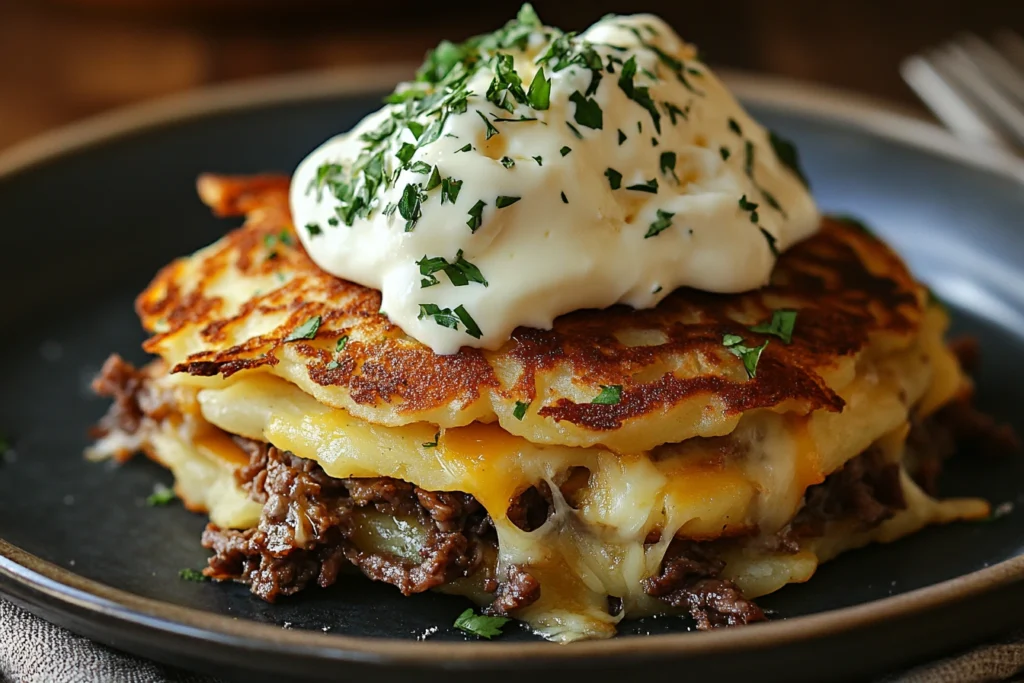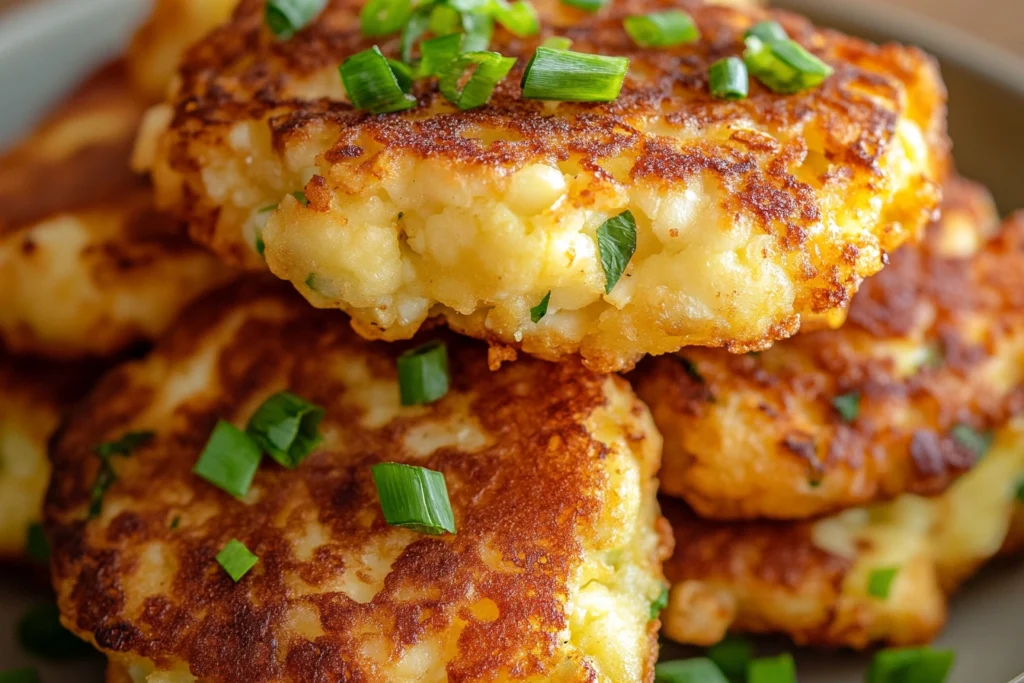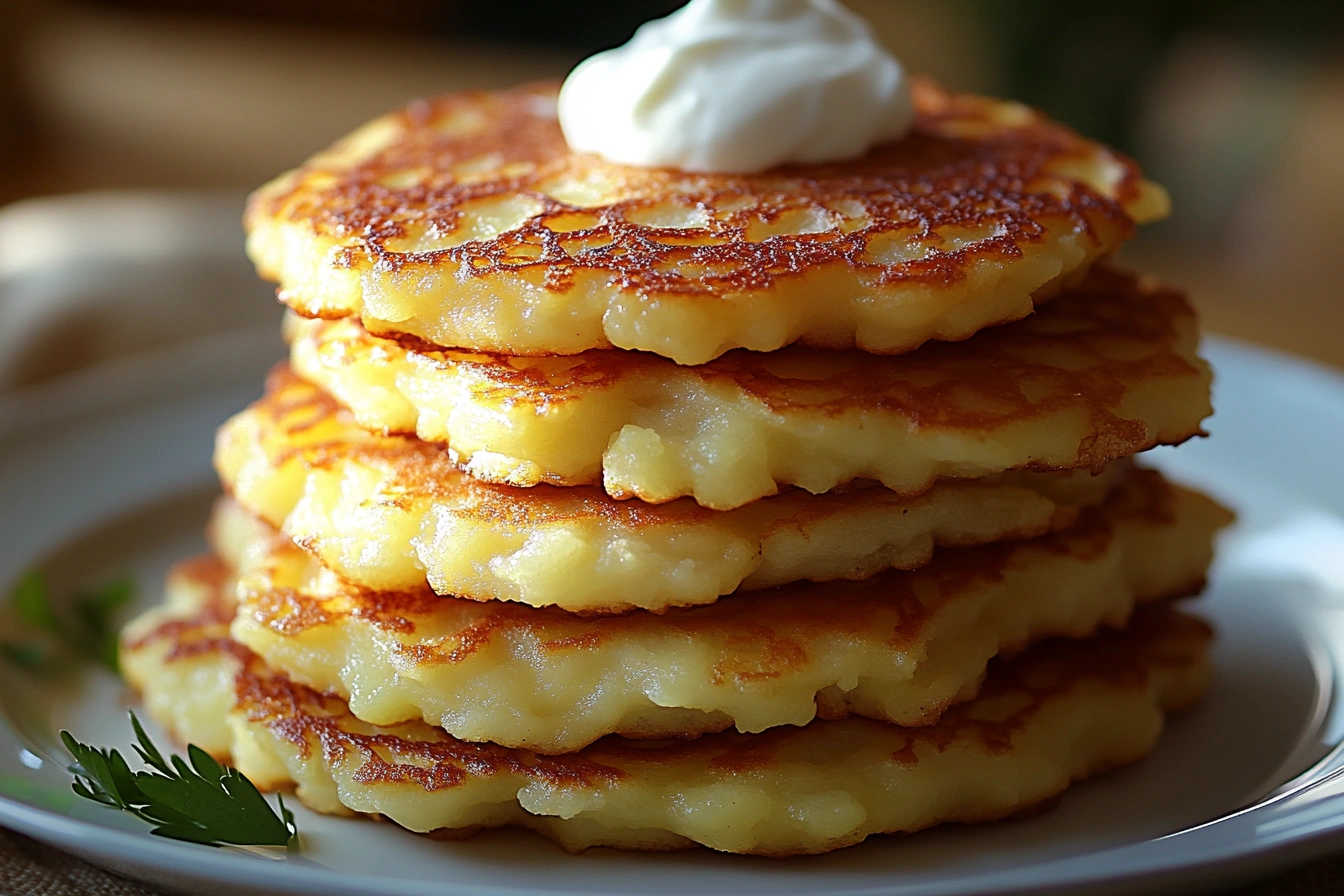When you think of comfort food, few dishes deliver the warmth, flavor, and satisfaction like a crispy tater cake. Whether enjoyed as a side dish, a main course, or even as a snack, tater cakes have earned a beloved spot in kitchens across the world. These golden, crispy cakes with a tender, fluffy inside are sure to please everyone at the table.
In this article, we will explore everything you need to know about tater cakes. First, we’ll dive into the origins of the dish. Then, we’ll guide you through an easy-to-follow step-by-step recipe, followed by various delicious variations. Additionally, we’ll share helpful tips and much more to ensure you master this savory treat. Whether you are a seasoned cook or a beginner in the kitchen, this recipe is sure to impress.
More Desserts : Sweet Potato Cake Recipe

Table of Contents
- What is a Tater Cake?
- History of Tater Cakes
- Why Tater Cakes Are So Popular
- Key Ingredients for a Perfect Tater Cake
- How to Make the Best Tater Cake
- Step-by-Step Guide
- Tater Cake Variations: Exploring Different Flavors
- Tips for Perfecting Your Tater Cake Recipe
- Troubleshooting Common Tater Cake Problems
- Serving Ideas for Tater Cakes
- How to Store and Reheat Tater Cakes
- Frequently Asked Questions
- Conclusion
What is a Tater Cake?
At its core, a Tater Cake Recipe is a simple yet incredibly satisfying dish made primarily from mashed potatoes. Once the potatoes are mashed, they are formed into small, round or oval-shaped patties and then pan-fried to golden perfection. The result is a crispy, crunchy crust that encases the soft, creamy potato center. While the name may seem casual, the flavor and texture of a tater cake make it a dish to be reckoned with.
The Basics of Tater Cakes
- Potatoes: Russet potatoes are often used in tater cakes because they provide a starchy, fluffy texture that holds together well when mashed and fried.
- Binding Ingredients: Eggs and flour help bind the mashed potatoes together, giving the cakes structure and allowing them to hold their shape while frying.
- Seasonings: Salt, pepper, garlic, and herbs are commonly used to season the cakes, adding flavor without overwhelming the natural potato taste.
What makes a Tater Cake Recipe so delightful is its balance of textures: crispy and crunchy on the outside, soft and pillowy on the inside. It’s a simple concept but one that can be modified in countless ways to suit different tastes and preferences.
History of Tater Cakes
Tater cakes have a rich and varied history, with versions of the dish popping up in various forms around the world. It’s widely believed that tater cakes originated from the need to use leftover mashed potatoes. As a result, this humble yet versatile dish quickly became a favorite in many households, offering a practical way to repurpose leftovers into something delicious. In times of economic hardship, people looked for ways to reuse leftover food to minimize waste and make meals stretch further.
The Rise of Tater Cakes in America
In the United States, tater cakes became a popular dish, particularly in the South, where potatoes were not only plentiful but also commonly used as a staple ingredient. Consequently, the dish gained widespread popularity as families embraced its simplicity and versatility, incorporating it into various meals. Tater cakes were an easy way to turn leftover mashed potatoes into a new meal that was both satisfying and budget-friendly. They were commonly served alongside meats, as a snack, or even as a main dish.
Although tater cakes have evolved over the years, their appeal remains the same. Simple ingredients, easy preparation, and delicious flavors make them a go-to comfort food for many.
Why Tater Cakes Are So Popular
There are several reasons why tater cakes have remained a beloved dish:
- Versatility: The basic tater cake can be adapted to suit any flavor profile. You can add cheese, bacon, herbs, or vegetables to suit your taste.
- Ease of Preparation: Tater cakes are incredibly simple to make. With just a few ingredients, you can create a satisfying meal in no time.
- Crispy and Creamy Texture: The combination of crispy golden edges and a tender, fluffy center makes tater cakes a textural delight.
- Affordability: Potatoes are inexpensive and accessible, making tater cakes an affordable option for families or anyone on a budget.
The simplicity and satisfaction of Tater Cake Recipe make them a dish that transcends generations, with each cook adding their own spin on the recipe.
Key Ingredients for a Perfect Tater Cake

To make the perfect tater cake, you’ll need a few key ingredients. Each one plays a vital role in creating the ideal balance of flavor and texture.
Potatoes: The Base of Tater Cakes
Russet potatoes are commonly used in Tater Cake Recipe because of their high starch content. This makes them perfect for achieving a creamy, smooth texture when mashed. Alternatively, you can also use Yukon Gold potatoes for a creamier and richer texture.
Flour: Binding Agent
Flour helps bind the mashed potatoes together, ensuring that the tater cakes hold their shape during frying. All-purpose flour is usually the go-to choice, but you can also experiment with gluten-free flours if desired.
Eggs: Binding and Moisture
Eggs act as a binding agent, helping the mixture stay together. They also provide moisture, which is essential for achieving the soft, creamy interior of the cake.
Seasonings: Flavor Boosters
Common seasonings include salt, pepper, garlic powder, onion powder, and paprika. These add flavor to the potatoes without overpowering the natural taste. You can also experiment with fresh herbs like parsley, thyme, or chives for added flavor.
Oil: Frying Medium
To achieve that signature golden, crispy exterior, you’ll need oil for frying. Choose oils with a high smoke point, such as canola oil, vegetable oil, or peanut oil.
Optional Add-ins: Customize Your Tater Cake
Feel free to get creative with your tater cakes by adding ingredients like shredded cheese, cooked bacon, or sautéed onions. These add-ins will elevate the flavor and make the dish more exciting.
How to Make the Best Tater Cake
Making tater cakes is a simple process, but following a few key steps ensures the best results. Here’s a detailed guide to help you create the perfect tater cakes every time.
Step-by-Step Guide to Making Tater Cakes

- Prepare the Potatoes: Peel and cube the potatoes. Boil them in salted water until fork-tender (about 15 minutes). Drain and mash the potatoes until smooth.
- Make the Mixture: In a large bowl, combine the mashed potatoes with flour, eggs, and your chosen seasonings. Mix until well combined. The mixture should be thick enough to form into patties, but not too dry.
- Shape the Patties: Take small portions of the potato mixture and shape them into round or oval patties. You can make them as small or as large as you like, but keep them uniform in size for even cooking.
- Fry the Patties: Heat oil in a skillet over medium-high heat. Once the oil is hot, carefully place the patties in the skillet, making sure not to overcrowd the pan. Fry for about 3-4 minutes on each side or until golden brown and crispy.
- Drain and Serve: Once the tater cakes are cooked, transfer them to a paper towel-lined plate to drain excess oil. Serve immediately while hot and crispy.
Tater Cake Variations: Exploring Different Flavors
One of the best parts about tater cakes is how versatile they are. You can mix in various ingredients to create unique flavors and textures. Here are some popular variations to try:
Cheddar Cheese and Bacon Tater Cakes
Add shredded cheddar cheese and cooked bacon bits to your mashed potatoes for a savory, indulgent flavor. These tater cakes are perfect for breakfast or brunch.
Herbed Tater Cakes
Add fresh herbs such as parsley, thyme, or chives to the mixture for a burst of freshness. This variation pairs well with grilled meats or as a light snack.
Spicy Tater Cakes
For a bit of heat, mix in finely diced jalapeños, cayenne pepper, or chili powder. Serve these with a cool dipping sauce to balance out the spice.
Veggie Tater Cakes
Incorporate finely chopped vegetables like onions, bell peppers, or spinach into the mixture for added color and nutrition.
Tips for Perfecting Your Tater Cake Recipe

To ensure your tater cakes turn out perfectly every time, here are some tips and tricks:
Use Starchy Potatoes
Russet potatoes are ideal for tater cakes due to their high starch content, which helps create a fluffy texture. Avoid waxy potatoes, like red potatoes, as they tend to be too firm for this recipe.
Don’t Overmix
When combining the mashed potatoes with the flour and other ingredients, mix just enough to incorporate everything. Overmixing can result in dense cakes that lack the desired fluffiness.
Maintain Oil Temperature
For crispy tater cakes, it’s important to fry them at the right temperature. If the oil is too hot, they will burn; if it’s too cold, they will absorb too much oil and become greasy. Keep the oil at a medium-high heat.
Chill the Patties
If you have time, refrigerating the formed patties for about 30 minutes before frying helps them hold their shape better during cooking.
Troubleshooting Common Tater Cake Problems
Here are some common issues you might encounter while making tater cakes and how to fix them:
- Tater cakes falling apart: This can happen if the potato mixture is too wet or not well-bound. Ensure you use enough flour and egg to bind the mixture together.
- Greasy tater cakes: If your cakes are greasy, it’s likely because the oil wasn’t hot enough. Make sure the oil is properly heated before frying, and avoid overcrowding the pan.
- Cakes too dense: If your tater cakes are too dense, try using less flour or mixing the ingredients more gently to avoid compacting the potatoes.
Serving Ideas for Tater Cakes
Tater cakes are incredibly versatile and can be served in a variety of ways. Here are some ideas:
- With Dips: Serve with sour cream, ranch dressing, or a spicy aioli for an extra layer of flavor.
- As a Side Dish: Pair tater cakes with a hearty main course like grilled steak, roasted chicken, or pork chops.
- As a Snack: Enjoy tater cakes as a delicious snack, either on their own or served with a dipping sauce.
How to Store and Reheat Tater Cakes
If you have leftover tater cakes, storing and reheating them properly ensures they stay just as delicious. To store, place the cooled cakes in an airtight container and refrigerate for up to 3 days. To reheat, heat a little oil in a skillet and fry the cakes for a couple of minutes on each side to bring back their crispiness.
Frequently Asked Questions
Can I make tater cakes in advance?
Yes! You can prepare the potato mixture ahead of time and refrigerate it for up to a day before shaping and frying the cakes. Alternatively, you can shape the patties and freeze them for future use.
Can I bake tater cakes instead of frying them?
Yes, you can bake tater cakes in the oven. Simply place the patties on a baking sheet, brush them with oil, and bake at 400°F (200°C) for about 20-25 minutes, flipping halfway through.
Conclusion
In conclusion, tater cakes are a delicious and versatile dish that anyone can make. From their humble origins as a way to use up leftover mashed potatoes to their modern-day popularity as a tasty snack, tater cakes remain a go-to comfort food in many households. With the right ingredients and a little know-how, you can easily master the art of tater cake-making and enjoy this crispy, golden treat at any meal.
Whether you’re following the classic recipe or experimenting with variations, tater cakes are sure to become a family favorite in no time.
